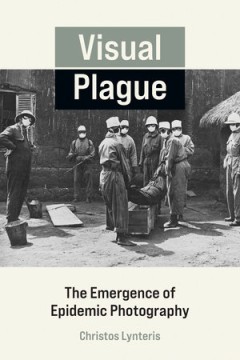Filter by

The Anthropology of Epidemics
Over the past decades, infectious disease epidemics have come to increasingly pose major global health challenges to humanity. The Anthropology of Epidemics approaches epidemics as total social phenomena: processes and events which encompass and exercise a transformational impact on social life whilst at the same time functioning as catalysts of shifts and ruptures as regards human/non-human re…
- Edition
- -
- ISBN/ISSN
- 9780429461897
- Collation
- -
- Series Title
- -
- Call Number
- -

Visual plague :the emergence of epidemic photography
"Visual Plague claims that what epidemic photography did, besides the individual visualization of each outbreak it depicted, was to transform the way in which we relate to infectious diseases, as both biological and historical agents"--OCLC-licensed vendor bibliographic record.
- Edition
- -
- ISBN/ISSN
- 0262370913
- Collation
- 1 online resource.
- Series Title
- -
- Call Number
- -

Sulphuric utopias :a history of maritime fumigation
"Sulphuric Utopias presents the comprehensive history of fumigation in early-twentieth-century global health. It tells the story of a technology that transformed global practices of maritime quarantine through the combination of chemical and engineering innovation. Fumigation combined chemical and industrial engineering so as to apply gases like sulphur dioxide and sulphuric acid to the task of…
- Edition
- -
- ISBN/ISSN
- 9780262358194
- Collation
- 1 online resource.
- Series Title
- -
- Call Number
- -

Sulphuric Utopias: A History of Maritime Fumigation
How early twentieth century fumigation technologies transformed maritime quarantine practices and inspired utopian visions of disease-free global trade. In the late nineteenth and early twentieth centuries, fumigation technologies transformed global practices of maritime quarantine through chemical and engineering innovation. One of these technologies, the widely used Clayton machine, blaste…
- Edition
- -
- ISBN/ISSN
- 9780262358194
- Collation
- -
- Series Title
- -
- Call Number
- 614.48

Human Extinction and the Pandemic Imaginary
This book develops an examination and critique of human extinction as a result of the ‘next pandemic’ and turns attention towards the role of pandemic catastrophe in the renegotiation of what it means to be human. Nested in debates in anthropology, philosophy, social theory and global health, the book argues that fear of and fascination with the ‘next pandemic’ stem not so much from an …
- Edition
- -
- ISBN/ISSN
- 9780429322051
- Collation
- -
- Series Title
- -
- Call Number
- 610

Visual Plague: The Emergence of Epidemic Photography
How epidemic photography during a global pandemic of bubonic plague contributed to the development of modern epidemiology and our concept of the “pandemic.” In Visual Plague, Christos Lynteris examines the emergence of epidemic photography during the third plague pandemic (1894–1959), a global pandemic of bubonic plague that led to over twelve million deaths. Unlike medical photography…
- Edition
- -
- ISBN/ISSN
- 9780262370912
- Collation
- -
- Series Title
- -
- Call Number
- 614.4
 Computer Science, Information & General Works
Computer Science, Information & General Works  Philosophy & Psychology
Philosophy & Psychology  Religion
Religion  Social Sciences
Social Sciences  Language
Language  Pure Science
Pure Science  Applied Sciences
Applied Sciences  Art & Recreation
Art & Recreation  Literature
Literature  History & Geography
History & Geography